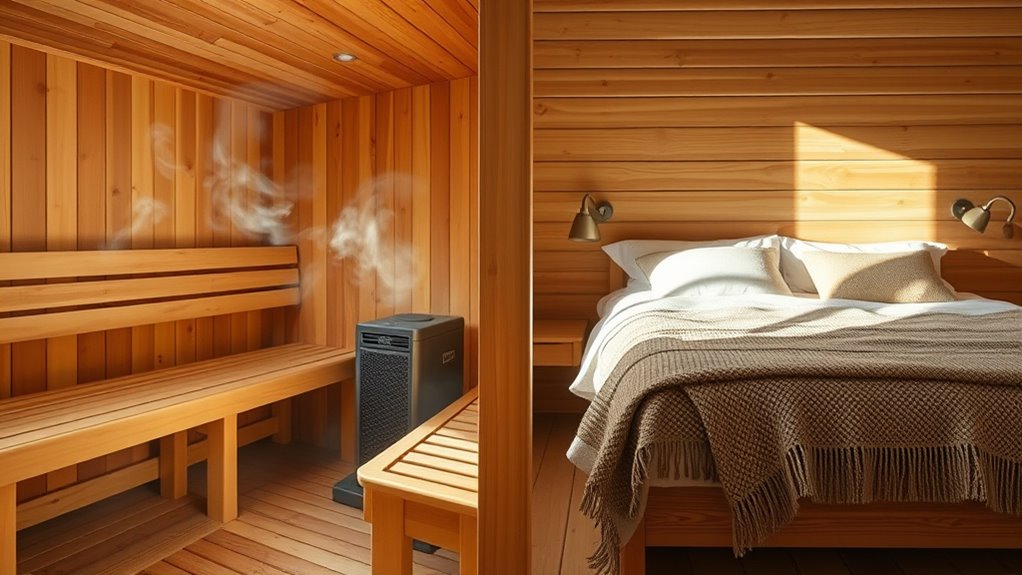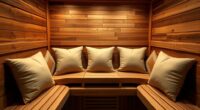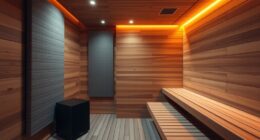To improve your sleep and recovery, use the sauna at least 1-2 hours before bed so your body can cool down and fall asleep easier. Timing matters because sauna too close to bedtime can disrupt your sleep cycle, which is regulated by your circadian rhythms and melatonin. Maintaining a consistent sleep schedule, creating a relaxing environment, and understanding how body temperature influences sleep can make a big difference. Keep exploring for more tips to optimize your routine.
Key Takeaways
- Sauna should be used 1-2 hours before sleep to promote relaxation and prevent sleep disruption.
- Maintaining consistent sleep and wake times supports your circadian rhythm and improves sleep quality.
- Melatonin production is triggered by darkness; avoid screens and bright lights before bed to enhance sleep onset.
- Cooling the body after sauna or warm activities helps signal readiness for sleep and improves sleep quality.
- Relaxation techniques and proper sauna timing reduce stress, enhance dreams, and support restorative sleep cycles.
Understanding Circadian Rhythms
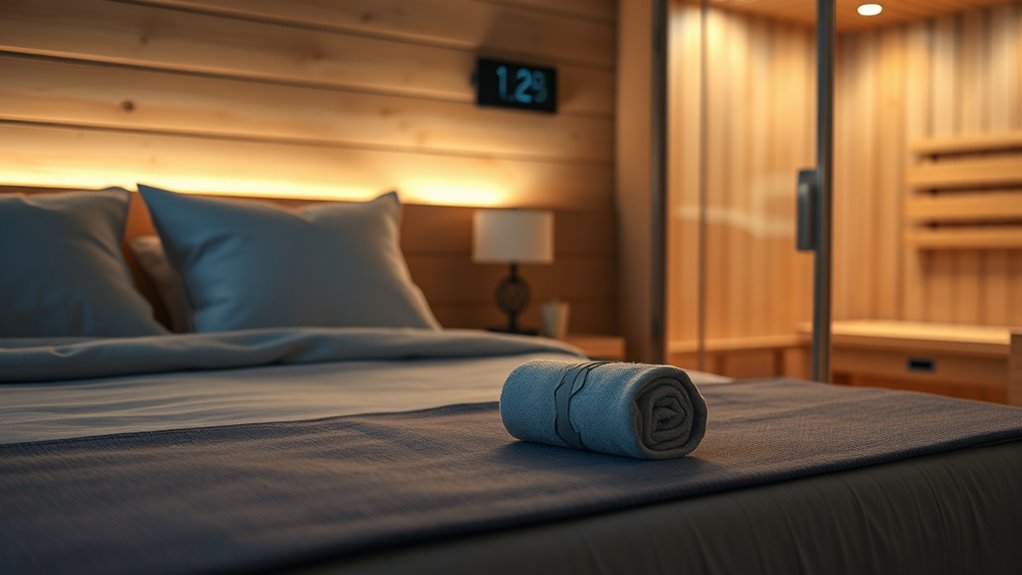
Understanding circadian rhythms is essential because they regulate your sleep-wake cycle and influence your overall health. When your internal clock aligns with natural light and darkness, you’re more likely to experience better sleep quality and vivid dream recall. Your sleep environment plays a pivotal role in supporting these rhythms—keeping your room dark, cool, and quiet helps reinforce your body’s natural timing. Disrupting your circadian rhythm, like staying up late or using screens before bed, can make it harder to remember dreams and feel rested. Paying attention to your sleep environment can significantly improve your sleep quality and dream clarity. By understanding how your biological clock works, you can better tailor your sleep habits and environment to promote restorative sleep and clearer dreams. This awareness helps you optimize your nightly rest and overall well-being.
The Role of Melatonin in Sleep Timing

Melatonin production is triggered by darkness, signaling your body that it’s time to sleep. The timing of this hormone release directly influences your sleep quality and duration. Understanding how melatonin works can help you optimize your sleep schedule and improve overall rest. To ensure safe and effective sleep strategies, it’s also important to be aware of potential sleep aids and supplements, which should be used cautiously and ideally under medical supervision.
Melatonin Production Triggers
The rise and fall of melatonin levels are closely tied to your body’s internal clock, signaling when it’s time to feel sleepy or alert. Melatonin production is initiated by darkness, which stimulates your brain to release this hormone. Light exposure, especially blue light from screens, can suppress melatonin triggers, delaying sleepiness. Your hormone regulation system responds to environmental cues, telling your body when to produce melatonin and prepare for rest. Natural evening darkness prompts melatonin triggers, helping you wind down. Conversely, bright mornings reduce melatonin levels, signaling wakefulness. This hormone regulation ensures your sleep-wake cycle stays synchronized with day and night. Understanding melatonin triggers helps you optimize your sleep timing by aligning your habits with your body’s natural rhythms.
Timing and Sleep Quality
Since your body’s internal clock relies heavily on melatonin to signal when it’s time to sleep, aligning your melatonin production with your desired sleep schedule can substantially improve sleep quality. Establishing consistent bedtime routines helps this process by cueing your body to produce melatonin at the right time. Your sleep environment also plays an essential role; a dark, cool, and quiet space supports natural melatonin secretion. To optimize timing, consider this table:
| Bedtime Routine | Sleep Environment | Melatonin Effect |
|---|---|---|
| Dim lights 1 hour before bed | Use blackout curtains | Promotes earlier melatonin release |
| Avoid screens 30 mins before sleep | Keep room cool (65°F/18°C) | Enhances sleep onset |
| Relaxing activities | Minimize noise | Supports deep sleep |
| Consistent sleep schedule | Remove bright lights | Maintains regular melatonin rhythm |
| Limit caffeine | Use calming scents | Ensures quality sleep |
A new sentence with sleep hygiene practices and the rest of the sentence.
How Body Temperature Affects Sleep and Sauna Use
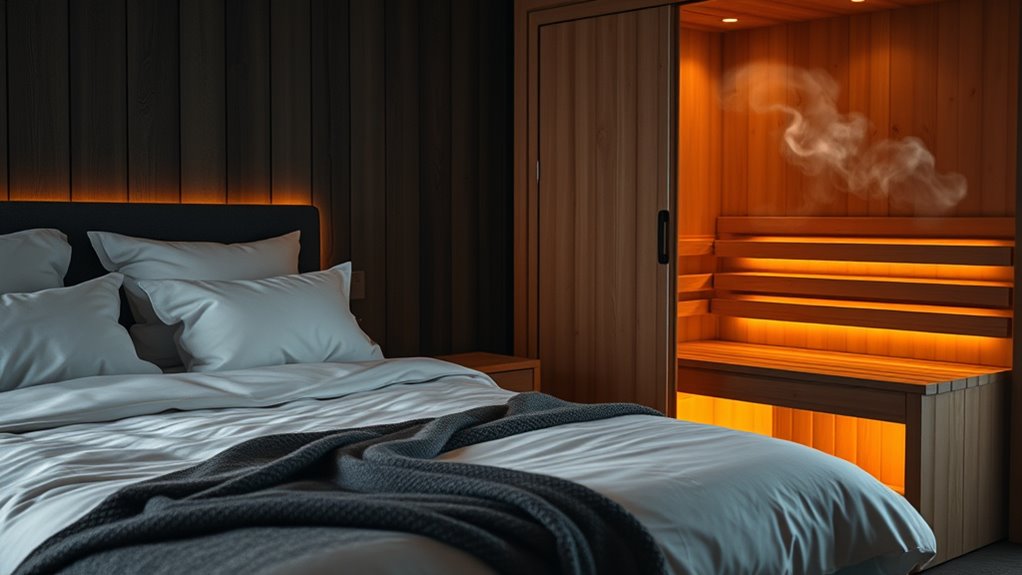
Your body temperature plays a key role in how easily you fall asleep and wake up refreshed. When your temperature drops at night, it signals your body to prepare for sleep, making timing important for sauna use. Understanding this link can help you optimize both your sleep quality and sauna sessions for better health. Incorporating air quality improvements like using air purifiers can further support restful sleep by reducing allergens and odors in your environment.
Body Temperature and Sleep
Body temperature plays a crucial role in regulating your sleep cycle, as fluctuations signal when it’s time to wind down or wake up. When your body cools down, it signals that sleep is approaching, enhancing your sleep hygiene. To boost body awareness and improve sleep, consider these tips:
- Keep your room cool before bedtime to facilitate natural body cooling.
- Take a warm bath or sauna session an hour before bed to help your body prepare for sleep.
- Avoid heavy meals or intense exercise close to bedtime, which can raise body temperature.
- Stick to a consistent sleep schedule to reinforce your body’s temperature rhythm.
- Incorporating relaxing activities before bed can further help lower your body temperature and promote restful sleep.
Understanding how body temperature impacts sleep helps you develop better sleep habits and optimize your sauna use for restorative rest.
Timing Sauna for Benefits
Timing your sauna sessions can profoundly influence how your body temperature interacts with your sleep cycle. If you sauna too close to bedtime, your body may still be too warm, disrupting your sleep hygiene and making it harder to fall asleep. To maximize benefits and maintain sauna safety, aim to finish your session at least 1-2 hours before bed. This allows your body temperature to cool naturally, promoting better sleep quality. Regularly timing your sauna use can help regulate your internal clock and improve overall rest. Remember to stay hydrated and listen to your body to avoid overheating. Properly timing your sauna sessions supports sleep hygiene, helping you fall asleep faster and enjoy more restorative sleep. For optimal results, consider ambient-light playbooks to enhance your relaxation routine and overall sleep environment.
What Is Thermal Regulation?
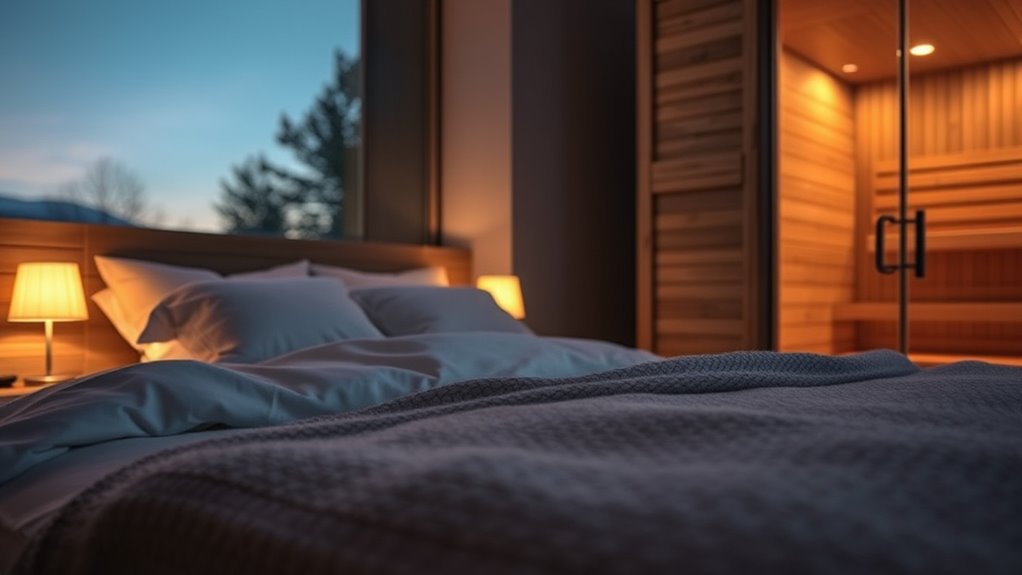
Thermal regulation is the process your body uses to maintain a stable internal temperature, essential for overall health and functioning. Your body keeps the core body temperature steady by managing heat production and heat dissipation. When you’re too hot, your body activates mechanisms like sweating and increased blood flow to the skin to cool down. Conversely, if you’re cold, it reduces blood flow and generates heat through shivering. Here’s how it works: Natural Techniques for Successful Commercial Seed Production include detecting temperature changes via skin and core sensors, sending signals to initiate cooling or warming responses. It uses sweat and increased blood flow for heat dissipation. Adjusts muscle activity for heat generation or conservation. This balance ensures your body’s functions run smoothly, especially during activities like sauna use or sleep.
Best Times to Use a Sauna for Relaxation
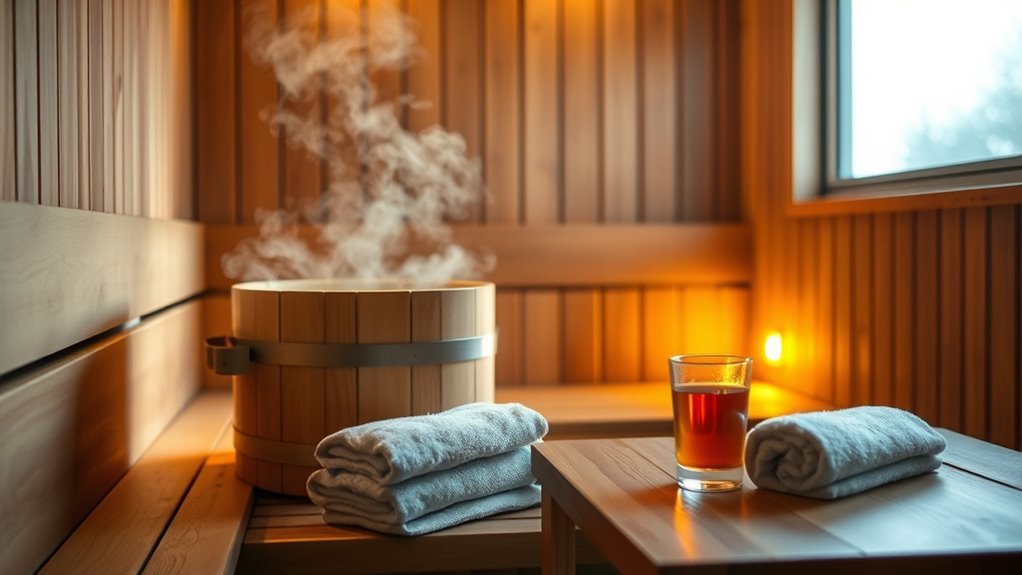
Knowing when to enjoy a sauna can enhance your relaxation experience and help you maximize its benefits. The best time is usually after a workout or in the evening, when your body is naturally more relaxed. Using meditation techniques during your sauna session can deepen your sense of calm, making relaxation more effective. It’s also essential to follow hydration strategies—drink water before and after to prevent dehydration and support your body’s thermal regulation. Avoid using the sauna immediately before bedtime if you find it energizes you; instead, aim for early evening or right after physical activity. This timing allows your body to relax fully and reduces any interference with your sleep. Proper timing ensures you enjoy the full calming effects while safeguarding your health.
The Sleep-Wake Cycle and Its Impact on Routine

Your sleep-wake cycle, also called the circadian rhythm, plays a crucial role in regulating your energy levels, mood, and overall health. When your routine aligns with this cycle, you sleep better and wake refreshed. To support this, consider:
Your circadian rhythm governs your sleep, mood, and health—aligning routines promotes better rest and well-being.
- Maintaining a consistent sleep schedule, even on weekends
- Creating a calming sleep environment, free of distractions
- Using dream journaling to track patterns and improve sleep quality
- Avoiding caffeine and screens before bedtime
- Incorporating sleep hygiene practices to enhance overall restfulness
Understanding your body’s natural rhythm helps you plan activities, like sauna sessions, to boost recovery without disrupting sleep. When your routine complements your circadian rhythm, it’s easier to fall asleep and stay rested. Adjusting your schedule to respect this cycle can improve your overall well-being.
Effects of Sauna Temperature and Duration on Relaxation
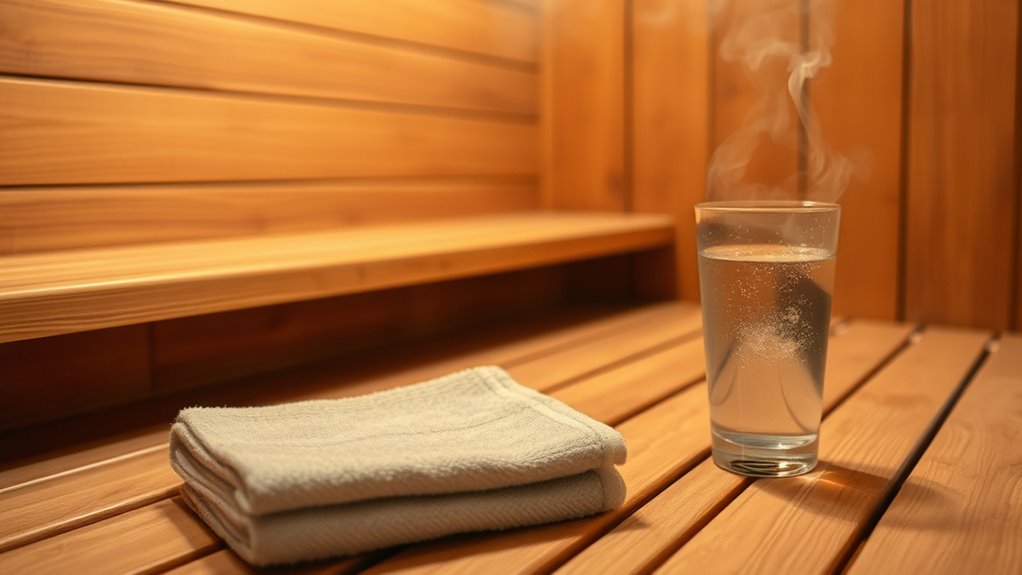
The temperature and duration of your sauna session considerably influence how deeply you relax and how effectively you reduce stress. Higher sauna temperatures, typically between 150°F and 195°F, promote greater muscle relaxation and sweating, which can enhance stress relief. However, staying too long in high heat may cause dizziness or fatigue, so moderation is key. A typical sauna duration of 15 to 20 minutes allows your body to benefit from the heat without overexertion. Shorter sessions may provide milder relaxation, while extended stays can deepen the calming effect but increase risks. Finding the right balance between sauna temperature and duration helps maximize relaxation, reduces tension, and promotes a sense of well-being without overwhelming your body. Incorporating eye patches after sauna sessions can further improve skin hydration and refresh tired eyes.
The Importance of Consistent Bedtime and Wake Time
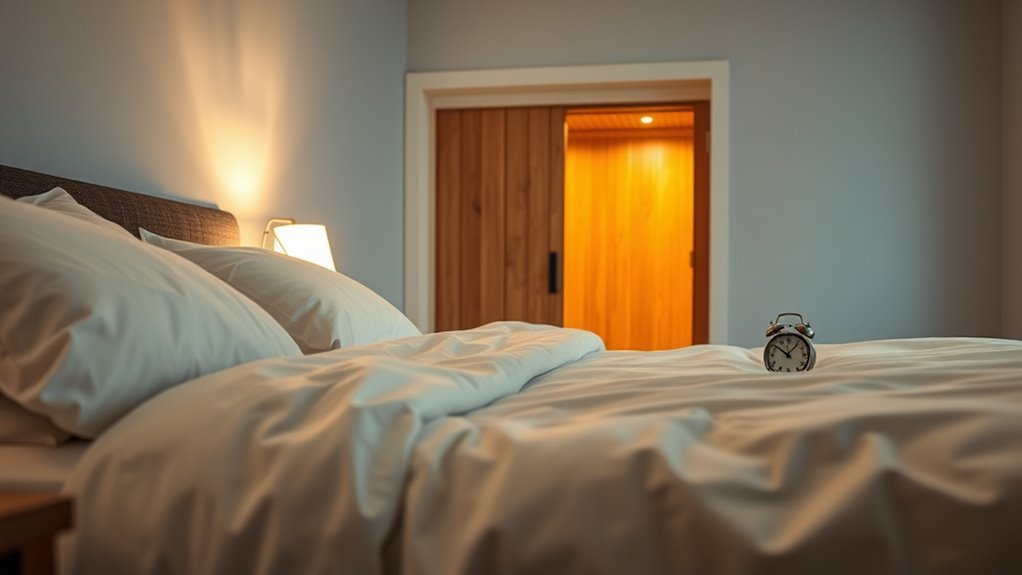
Maintaining a consistent bedtime and wake time helps regulate your body’s internal clock, making it easier to fall asleep and wake up feeling refreshed. When your sleep schedule stays steady, your body adapts quickly, improving sleep quality. To support this, focus on: 1. Establishing calming bedtime routines that signal it’s time to sleep 2. Keeping your wake time consistent, even on weekends 3. Creating morning habits that reinforce your schedule, like exposure to natural light 4. Avoiding caffeine or screens close to bedtime, which can disrupt your rhythm and promote better sleep hygiene.
How Relaxation Phases Influence Sleep Quality
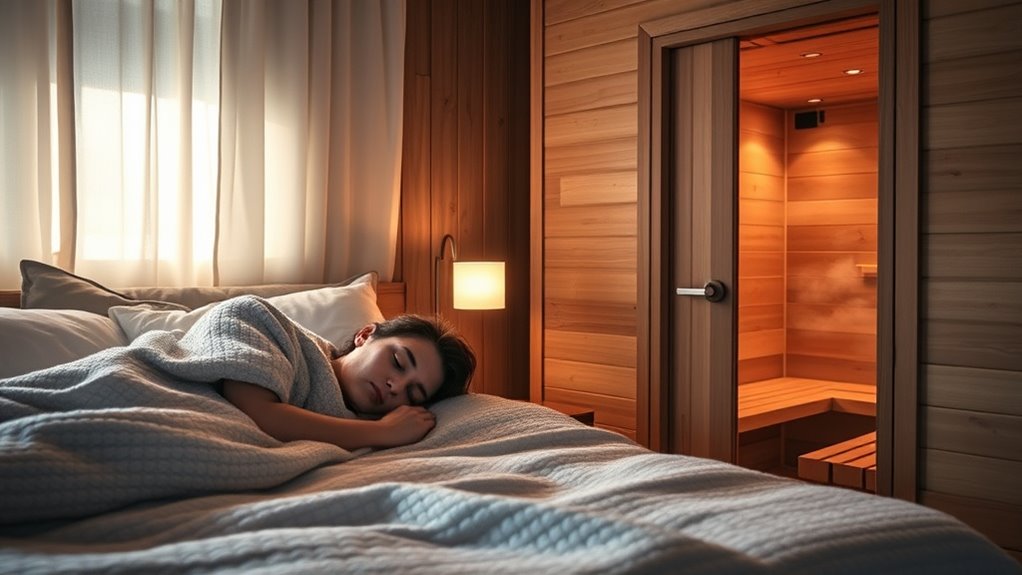
Relaxation phases help deepen your sleep and make it more restorative. When you reduce stress before bed, your body shift smoothly into restful sleep cycles. Proper timing of relaxation techniques, like sauna use, can enhance these effects and improve your overall sleep quality.
Relaxation and Sleep Depth
When your body enters relaxation phases before sleep, it sets the stage for deeper, more restorative rest. During this time, activities like meditative breathing help calm your mind, while aromatherapy benefits enhance your sense of tranquility. These relaxation techniques boost sleep depth by reducing stress hormones and promoting a peaceful state. To maximize this effect, consider:
- Practicing slow, deep breaths to activate your relaxation response
- Using calming scents like lavender or chamomile for aromatherapy benefits
- Dimming lights to signal your body it’s time to wind down
- Avoiding screens to prevent interference with your relaxation process
Sauna’s Stress Reduction Role
Engaging in relaxation techniques before bed not only calms your mind but also prepares your body for restorative sleep. Using sauna sessions as part of your stress reduction techniques can substantially lower cortisol levels and promote relaxation. When you incorporate sauna use into your routine, guarantee sauna safety tips are followed, like staying hydrated and avoiding alcohol. The heat from the sauna helps relax tense muscles and reduces overall stress, making it easier to shift into sleep. By creating this calming pre-sleep environment, you enhance your body’s ability to enter deeper sleep stages. Regularly practicing stress reduction techniques such as sauna sessions can improve sleep quality and help you wake feeling more refreshed and less anxious.
Timing and Sleep Cycles
The timing of relaxation techniques, such as sauna sessions, can markedly influence your sleep cycles. When scheduled correctly, they help improve your sleep environment and promote dream enhancement. Here’s how you can optimize this:
- Finish sauna sessions at least an hour before bed to allow your body to cool down, aligning with natural sleep rhythms.
- Create a calming sleep environment by dimming lights and reducing noise after relaxation to enhance sleep quality.
- Maintain a consistent sleep schedule to support healthy sleep cycles and maximize the benefits of relaxation.
- Use relaxation techniques during the evening to help transition into deeper sleep stages, boosting dream vividness and overall restfulness.
Timing Your Sauna Sessions for Optimal Sleep Benefits
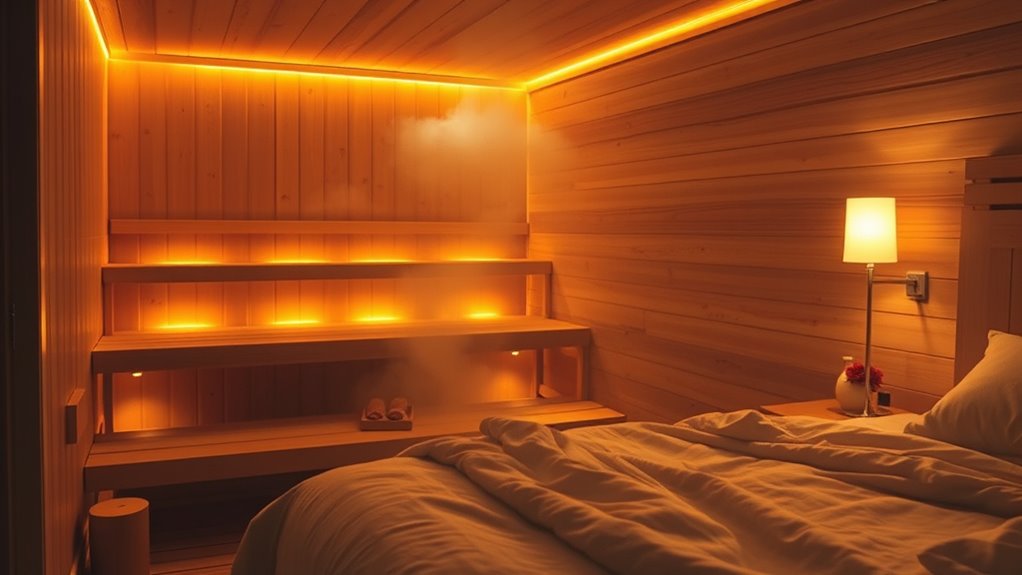
Timing your sauna sessions can considerably influence the quality of your sleep. To maximize benefits, aim to finish your sauna at least an hour before bed, giving your body time to cool down. Proper hydration needs are essential; drink plenty of water before and after your session to prevent dehydration and support relaxation. Using sauna accessories like a towel or a cooling cloth can enhance comfort and help regulate your body temperature. Avoid intense sessions right before sleep, as excessive heat can disrupt your ability to fall asleep. Instead, opt for a moderate session that promotes relaxation without overstimulating you. By mindfully timing your sauna and paying attention to hydration and accessories, you create the ideal conditions for restful, restorative sleep.
Frequently Asked Questions
How Does Sauna Use Impact Sleep Quality Long-Term?
Using a sauna regularly can improve your sleep quality long-term by relaxing your muscles and reducing stress. However, it’s essential to follow hydration strategies to prevent dehydration, which can disrupt sleep. Always prioritize sauna safety by avoiding excessive heat exposure and listening to your body. Over time, consistent sauna use may help you fall asleep faster and enjoy more restful sleep, but stay mindful of your hydration and safety to maximize benefits.
Can Sauna Timing Help With Sleep Disorders?
Think of sauna timing as a gentle river guiding you toward restful shores, helping with sleep disorders. Proper timing enhances meditation benefits by calming your mind and body, much like a soothing current. To optimize this, combine it with hydration strategies to prevent dehydration and support relaxation. When done thoughtfully, sauna sessions at the right time can create a peaceful rhythm, easing your sleep struggles and promoting better rest.
Does Sauna Use Affect Sleep Latency or Time to Fall Asleep?
Sauna use can influence your sleep latency by creating thermal effects that raise your body temperature, which then drops afterward, signaling your body to prepare for sleep. This thermal shift can help regulate circadian rhythms, making it easier to fall asleep faster. However, timing matters—using a sauna too close to bedtime might temporarily disrupt sleep patterns, so aim for earlier sessions to maximize relaxation and promote quicker sleep onset.
Are There Age-Related Considerations for Sauna and Sleep Timing?
Yes, age-related metabolism and sleep pattern changes influence sauna and sleep timing. As you age, your metabolism slows, making it harder to cool down and fall asleep after a sauna session. Older adults often experience lighter, more fragmented sleep, so it’s best to avoid sauna use close to bedtime. Adjust your sauna schedule to earlier in the day to promote better sleep quality and accommodate these age-related changes.
How Do Different Sauna Types Influence Sleep and Relaxation?
Ever wonder how different sauna types affect your sleep and relaxation? Infrared saunas gently warm your body, promoting relaxation without intense heat, which can improve sleep quality. Steam rooms, with their high humidity and heat, help relax muscles but might be overstimulating for some before bed. Choosing between them depends on your comfort; infrared might be better for winding down, while steam rooms energize or invigorate.
Conclusion
You might find it surprising how syncing your sauna sessions with your body’s natural rhythms can boost your sleep quality. When you understand your circadian patterns and temperature cues, relaxation becomes effortless. The coincidence? A simple adjustment in timing could release better rest and relaxation, without overhauling your routine. So, next time you enjoy a sauna, remember—tuning into your body’s signals might be the key to truly restful nights.
